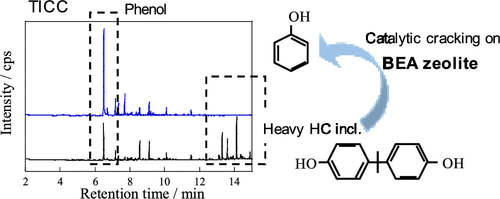当前位置:
X-MOL 学术
›
Ind. Eng. Chem. Res.
›
论文详情
Our official English website, www.x-mol.net, welcomes your feedback! (Note: you will need to create a separate account there.)
Selective Phenol Recovery by Catalytic Cracking of Thermal Decomposition Gas from Epoxy-Based Carbon-Fiber-Reinforced Plastic
Industrial & Engineering Chemistry Research ( IF 4.2 ) Pub Date : 2020-07-09 , DOI: 10.1021/acs.iecr.0c02152 Kazumasa Oshima 1 , Hiromasa Fujii 2 , Kazumasa Morita 1 , Masaki Hosaka 1 , Takashiro Muroi 2 , Shigeo Satokawa 1
Industrial & Engineering Chemistry Research ( IF 4.2 ) Pub Date : 2020-07-09 , DOI: 10.1021/acs.iecr.0c02152 Kazumasa Oshima 1 , Hiromasa Fujii 2 , Kazumasa Morita 1 , Masaki Hosaka 1 , Takashiro Muroi 2 , Shigeo Satokawa 1
Affiliation

|
To promote the recycling of carbon-fiber-reinforced plastic (CFRP), catalytic cracking of hazardous gases generated by thermal decomposition from epoxy-based CFRP composites was performed. We aimed for selective phenol recovery and hazardous gas removal using a zeolite catalyst. The BEA-type zeolite with Si/Al = 92.5 showed high conversion and low naphthalene selectivity. Thermal decomposition at 500 °C produced bisphenol from the epoxy resin in the CFRP. Then, bisphenol was decomposed into phenol, cresol, and methylbenzofuran over the zeolite catalyst. However, naphthalene was formed under long contact time conditions. The temperature for catalytic cracking could be decreased to 350 °C, which was lower than that for the CFRP thermal decomposition (around 500 °C). Therefore, the process of selective phenol recovery and hazardous gas removal from CFRP thermal decomposition gas can be driven by the waste heat generated during CFRP thermal decomposition.
中文翻译:

通过催化裂化从环氧基碳纤维增强塑料中的热分解气体选择性回收苯酚
为了促进碳纤维增强塑料(CFRP)的循环利用,对环氧基CFRP复合材料热分解产生的有害气体进行了催化裂化。我们的目标是使用沸石催化剂选择性地回收苯酚和去除有害气体。Si / Al = 92.5的BEA型沸石显示出高转化率和低萘选择性。在500°C下热分解,从CFRP中的环氧树脂中产生双酚。然后,将双酚在沸石催化剂上分解为苯酚,甲酚和甲基苯并呋喃。但是,萘是在长时间的接触条件下形成的。催化裂化的温度可以降至350°C,低于CFRP热分解的温度(约500°C)。因此,
更新日期:2020-07-29
中文翻译:

通过催化裂化从环氧基碳纤维增强塑料中的热分解气体选择性回收苯酚
为了促进碳纤维增强塑料(CFRP)的循环利用,对环氧基CFRP复合材料热分解产生的有害气体进行了催化裂化。我们的目标是使用沸石催化剂选择性地回收苯酚和去除有害气体。Si / Al = 92.5的BEA型沸石显示出高转化率和低萘选择性。在500°C下热分解,从CFRP中的环氧树脂中产生双酚。然后,将双酚在沸石催化剂上分解为苯酚,甲酚和甲基苯并呋喃。但是,萘是在长时间的接触条件下形成的。催化裂化的温度可以降至350°C,低于CFRP热分解的温度(约500°C)。因此,



























 京公网安备 11010802027423号
京公网安备 11010802027423号